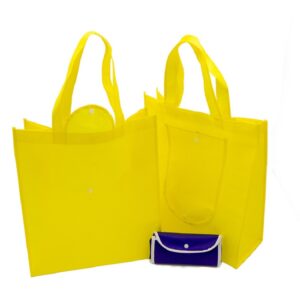Nonwoven fabrics come in various types, each designed for specific purposes and manufactured using different techniques.
Some common classifications or types of nonwoven fabrics include:
- Spunbond Nonwovens: Created by extruding continuous filaments of a polymer and bonding them together. Spunbond fabrics are durable, resistant to tearing, and commonly used in applications like disposable clothing, packaging, and geotextiles.
- Meltblown Nonwovens: Formed by blowing molten polymer through fine nozzles, creating microfibers that are collected and bonded together. Meltblown fabrics have excellent filtration properties and are used in masks, air filters, and medical applications.
- Needle-punched Nonwovens: Produced by mechanically entangling fibers using barbed needles. These fabrics are strong, durable, and find applications in carpets, geotextiles, automotive interiors, and insulation.
- Spunlace Nonwovens: Created by entangling fibers through high-pressure water jets. Spunlace fabrics are soft, absorbent, and used in wipes, hygiene products, medical dressings, and filtration.
- Airlaid Nonwovens: Formed by a process similar to papermaking, using air to deposit fibers onto a porous conveyor belt. Airlaid fabrics are absorbent and find applications in hygiene products, absorbent cores, and wipes.
- Composite Nonwovens: Combination of two or more different types of nonwoven fabrics or other materials. These composites are designed to achieve specific properties, non woven suppliers such as combining strength with absorbency or barrier functions.
- Wet-laid Nonwovens: Produced by suspending fibers in a water solution, then depositing them onto a moving screen. Wet-laid fabrics are used in applications requiring high absorbency like tea bags, wipes, or medical dressings.
- Thermal Bonded Nonwovens: Created by using heat and pressure to bond fibers together. These fabrics are used in a variety of applications such as hygiene products, furniture, and filtration.
Each type of nonwoven fabric offers distinct properties and functionalities, making them suitable for various applications across industries. The choice of nonwoven fabric type depends on the specific requirements of the end-use application.
What types of raw materials are typically used in manufacturing nonwoven fabric?
Nonwoven fabrics can be manufactured using a variety of raw materials, depending on the desired properties and end-use applications.
Some typical raw materials used in the production of nonwoven fabrics include:
- Polypropylene (PP): Widely used in nonwoven fabric production due to its versatility, durability, and cost-effectiveness. PP fibers are common in applications such as hygiene products, geotextiles, and packaging.
- Polyester (PET): Known for its strength, resilience, and resistance to stretching, making it suitable for durable nonwoven fabrics used in geotextiles, automotive interiors, and apparel.
- Polyethylene (PE): Used in nonwovens requiring water resistance or barrier properties. PE is often found in packaging materials, disposable products, and medical applications.
- Viscose/Rayon: Derived from natural sources like wood pulp or bamboo, viscose or rayon fibers are often blended with synthetic fibers to enhance absorbency and softness in nonwoven fabrics, commonly used in hygiene products and wipes.
- Natural Fibers: Although less common, natural fibers like cotton, hemp, or bamboo can be used in nonwoven fabric production, especially in eco-friendly or specialty applications where biodegradability and sustainability are emphasized.
- Recycled Materials: With increasing focus on sustainability, recycled plastics (e.g., recycled PET) and recycled fibers from post-consumer or post-industrial sources are being used in nonwoven fabric production to reduce environmental impact.
The choice of raw material depends on various factors such as desired properties (strength, absorbency, barrier functions), cost considerations, environmental impact, and the intended end-use application of the nonwoven fabric. Manufacturers often blend or treat these materials to achieve specific performance characteristics required by their target markets.
